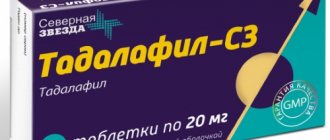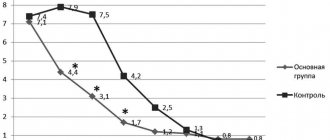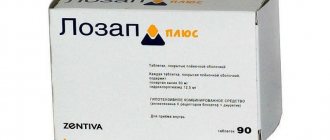Compound
| Film-coated tablets | 1 table |
| active substance: | |
| simvastatin | 10 mg |
| 20 mg | |
| 40 mg | |
| excipients: ascorbic acid - 2.5/5/10 mg; butylated hydroxyanisole - 0.02/0.04/0.08 mg; pregelatinized starch - 10/20/40 mg; citric acid monohydrate - 1.25/2.5/5 mg; magnesium stearate - 1.7/3.4/6.8 mg; MCC - 5/10/20 mg; lactose monohydrate - up to 100 mg/up to 200 mg/up to 400 mg | |
| film shell: Opadry pink OY-B-34915 (polyvinyl alcohol, titanium dioxide (E171), talc, lecithin, xanthan gum (E415), red iron oxide dye (E172), yellow iron oxide dye (E172), aluminum-based varnish indigo carmine dye) - 3/−/− mg; Opadry pink OY-B-34917 (polyvinyl alcohol, titanium dioxide (E171), talc, lecithin, xanthan gum (E415), red iron oxide dye (E172), yellow iron oxide dye (E172), black iron oxide dye (E172) — −/6/− mg; Opadry brown AMB 80W36564 (polyvinyl alcohol, titanium dioxide (E171), talc, lecithin, xanthan gum (E415), red iron oxide dye (E172), yellow iron oxide dye (E172), iron dye black oxide (E172) — −/−/12 mg |
Pharmacological properties
Pharmacodynamics
Simvastatin is a lipid-lowering agent obtained synthetically from a fermentation product of Aspergillus terreus. In the body it undergoes hydrolysis, resulting in the formation of a hydroxy acid derivative. This active metabolite is capable of inhibiting the enzyme HMG-CoA reductase (3-hydroxy-3-methyl-glutaryl-CoA reductase), which catalyzes the starting reaction for the synthesis of mevalonate from HMG-CoA. Since the process of converting HMG-CoA into mevalonate occurs in the early stages of cholesterol formation, the use of the drug does not lead to the accumulation of potentially toxic sterols in the body. HMG-CoA is metabolized to acetyl-CoA, which is involved in many synthesis processes in the body.
Simvastatin reduces the content of low-density lipoproteins, very low-density lipoproteins, triglycerides and total cholesterol in the blood plasma (with mixed hyperlipidemia and heterozygous non-familial and familial hypercholesterolemia, when high plasma cholesterol is a risk factor).
The drug also increases the level of high-density lipoproteins and reduces the ratios of total cholesterol/high-density lipoproteins and low-density lipoproteins/high-density lipoproteins.
The effect appears 2 weeks after starting to take Simgal, and the maximum therapeutic effect is achieved after 4-6 weeks. With continued therapy, the effect persists. If treatment is stopped, the cholesterol level gradually returns to its original value.
Pharmacokinetics
Simvastatin is rapidly absorbed from the gastrointestinal tract. The maximum concentration is reached 1.3–2.4 hours after taking the drug orally, and after 12 hours it decreases by 90%. Simvastatin is approximately 95% bound to plasma proteins.
Metabolism of the drug occurs in the liver, resulting in the formation of active and inactive metabolites. T1/2 (half-life) of active metabolites of simvastatin is 1.9 hours.
About 60% of the drug is excreted in the form of metabolites in the feces. Approximately 10–15% of simvastatin is excreted in an inactive form by the kidneys.
Directions for use and doses
Orally, 1 time per day in the evening, with a sufficient amount of water. The dose of Simgal is from 5 to 80 mg/day. Dose changes, if necessary, should be made at intervals of at least 4 weeks. A dose of 80 mg/day is recommended for use only in patients who have not achieved the desired result in LDL concentration when taking a dose of 40 mg and in patients taking diltiazem concomitantly with Simgal.
The maximum dose should not exceed 40 mg/day in the evening and is recommended only in cases of severe hyperlipidemia and in patients at high risk of cardiovascular disease.
Hyperlipidemia
Primary hyperlipidemia (type IIa according to the Fredrickson classification) or mixed hyperlipidemia (type IIb according to the Fredrickson classification). Before treatment, the patient should be prescribed a hypocholesterol diet, which should be followed during the entire course of treatment with simvastatin. The initial dose is 10–20 mg/day. If effectiveness is insufficient, the dose is increased no earlier than after 4 weeks. If a more significant reduction in LDL levels in the blood is necessary (by 45% or more), the initial dose may be 20–40 mg/day. If necessary, the dosage should be changed.
Hereditary homozygous hyperlipidemia. The recommended dose is 40 mg/day once in the evening or 80 mg/day divided into 3 doses (20 mg in the morning, 20 mg in the afternoon and 40 mg in the evening). A dose of 80 mg is recommended to be prescribed only if the expected benefit of therapy outweighs the possible risk. Simgal should be used as an adjunct or when lipid-lowering treatment is ineffective.
Cardiac ischemia
The recommended dose of Simgal is 20–40 mg/day once in the evening in patients with coronary artery disease with or without hyperlipidemia. If the LDL level is at least 75 mg/dL (1.94 mmol/L) and the total cholesterol level is less than 140 mg/dL (3.6 mmol/L), the dose of the drug must be reduced. Therapy with Simgal can be started simultaneously with diet and increased physical activity. If there is insufficient effectiveness, the dose is adjusted, but not earlier than after 4 weeks.
Concomitant drug therapy
The drug Simgal is effective both in monotherapy and in combination with bile acid sequestrants. Simgal should be taken 2 hours before or 4 hours after taking bile acid sequestrants.
When taking cyclosporine, danazol, gemfibrozil, other fibrates (except fenofibrate) or lipid-lowering doses (at least 1 g/day) of nicotinic acid simultaneously with Simgal, the dose of Simgal should not exceed 10 mg/day.
When taking Simgal and amiodarone or verapamil simultaneously, the dose of Simgal should not exceed 20 mg/day.
For patients taking diltiazem, the daily dose of Simgal should not exceed 40 mg.
For patients taking amlodipine, the daily dose of Simgal should not exceed 40 mg.
With the simultaneous use of ranolazine and the drug Simgal, the concentration of simvastatin in the blood plasma increases.
Use for renal failure
No dose adjustment of Simgal is required for mild to moderate renal failure. In severe renal failure (Cl creatinine <30 ml/min), the daily dose should not exceed 10 mg, and close monitoring of the patient's condition during treatment is also necessary.
In elderly patients, no dose adjustment is required.
Side effects of the drug Simgal
The frequency of adverse events recorded during clinical trials and during the post-marketing period of use is classified based on the assessment of the frequency of their occurrence in large, long-term, placebo-controlled clinical studies, including the HPS (Heart Protection Study) and 4S (Scandinavian Simvastatin Survival Study) study. involving 20,536 and 4,444 patients, respectively. In the HPS study, only serious adverse events were recorded, such as myalgia, increased serum transaminases and CPK. All of the following side effects were recorded in Study 4S. If the incidence of adverse events with simvastatin in these studies was lower than or similar to that observed in the placebo group and the reports indicated the same causal relationship, then such adverse events were classified as rare. The frequency of side effects is ranked as follows: very often (1/10), often (1/100, ≤1/10), infrequently (1/1000, ≤1/100), rarely (1/10,000, ≤1/1000) , very rare (≤1/10,000), including isolated reports. From the blood and lymphatic systems. Rarely: anemia. From the nervous system. Rarely: headache, sleep disturbance, paresthesia, dizziness, peripheral neuropathy. From the gastrointestinal tract. Rarely: constipation, abdominal pain, flatulence, dyspepsia, diarrhea, nausea, vomiting, pancreatitis. Hepatobiliary disorders. Rarely: hepatitis/jaundice. From the skin and its appendages. Rarely: rash, itching, alopecia. From the musculoskeletal system Rarely: myopathy, rhabdomyolysis, myalgia, muscle cramps. General violations. Rarely: asthenia. Hypersensitivity syndrome rarely develops: angioedema, arthralgia, urticarial rash, lupus syndrome, polymyalgia rheumatica, dermatomyositis, vasculitis, thrombocytopenia, eosinophilia, increased ESR, arthritis and photosensitivity, fever, hot flashes, shortness of breath, weakness. From the laboratory parameters. Rarely: increased serum transaminases (AlAT, AST, gamma-glutamyl transpeptidase), increased levels of alkaline phosphatase, CPK in the blood serum.
Overdose
In case of an overdose of the drug, no specific symptoms are registered (there are several cases where Simgal was taken at a dose of 450 mg).
Treatment is standard: it is necessary to induce vomiting and give the patient activated charcoal. If necessary, symptomatic therapy is prescribed. Serum creatine phosphokinase levels and renal and hepatic function should also be monitored.
If acute renal failure develops and myopathy with rhabdomyolysis occurs, the drug should be immediately discontinued and the patient should be given sodium bicarbonate as an intravenous infusion and a diuretic. If necessary, hemodialysis is performed.
Hyperkalemia, which can be caused by rhabdomyolysis, is eliminated by intravenous administration of calcium gluconate or calcium chloride, infusion of glucose and insulin, the use of potassium ion exchangers, and in severe cases, hemodialysis.
Contraindications
Absolute:
- active liver disease or elevated serum liver enzymes of unknown origin;
- pronounced decrease in blood pressure;
- myopathy;
- severe acute infectious diseases;
- injuries;
- planned surgery;
- severe metabolic disorders;
- simultaneous use with itraconazole, ketoconazole, clarithromycin, nefazodone, erythromycin, telithromycin, HIV protease inhibitors and other CYP3A4 inhibitors;
- lactase deficiency, lactose intolerance or glucose-galactose malabsorption syndrome (the drug contains lactose);
- children and adolescents under 18 years of age (the safety and effectiveness of Simgal in children have not been established);
- pregnancy period;
- breastfeeding period;
- hypersensitivity to the main or auxiliary components, as well as other statin drugs.
Relative (Simgal is used with caution):
- conditions in which the development of severe renal failure is possible (acute severe infectious diseases, water and electrolyte imbalance, arterial hypotension, severe endocrine disorders, etc.);
- the presence of risk factors for the development of rhabdomyolysis/myopathy [uncontrolled hypothyroidism, impaired renal function (creatinine clearance less than 30 ml/min), advanced age over 65 years, rhabdomyolysis/myopathy associated with taking fibrates and statins (history), use in women, alcoholism , family history of muscle diseases];
- epilepsy;
- increased or decreased skeletal muscle tone of unknown origin;
- postoperative period in transplant patients receiving immunosuppressants;
- drinking alcohol in large quantities;
- simultaneous use with gemfibrozil, danazol, cyclosporine and other fibrates (except fenofibrate), amiodarone, diltiazem, verapamil, fusidic acid, grapefruit juice and nicotinic acid (in lipid-lowering doses ≥1 g per day).
Drug interactions
The risk of developing myopathy increases with simultaneous use of Simgal with antifungal drugs, immunosuppressants, HIV protease inhibitors, cytostatics, high doses of nicotinic acid, clarithromycin, nefazodone, gemfibrozil and other fibrates (except fenofibrate), erythromycin and telithromycin.
When danazol, cyclosporine, verapamil, amiodarone, diltiazem or amlodipine are co-administered with high doses of simvastatin, the likelihood of rhabdomyolysis/myopathy increases.
Simgal potentiates the effect of indirect anticoagulants and increases the risk of bleeding; increases plasma concentrations of digoxin.
During treatment with simvastatin, you should avoid drinking large amounts of grapefruit juice.
special instructions
If muscle weakness or lethargy, muscle soreness, unexplained pain, especially accompanied by fever and malaise, occurs during treatment with Simgal, you should immediately consult a doctor, as these symptoms may be signs of developing myopathy.
According to the instructions, Simgal should be discontinued several days before the planned surgical intervention (including dental surgery) and not used in the postoperative period.
It is recommended that liver function tests be performed before starting therapy, regularly during treatment, and at each dose increase.
In patients with nephrotic syndrome and certain other kidney diseases, as well as in those with hypothyroidism, the underlying disease is first treated.
Simgal is not indicated for hypertriglyceridemia types 1, 4 and 5.
When the patient has forgotten to take the next dose, it should be taken as soon as possible, but if it is time for the next dose, the dose should not be doubled.
The duration of the course is determined by the attending physician.
During treatment with Simgal, care must be taken when driving a car and operating other potentially dangerous mechanisms.



